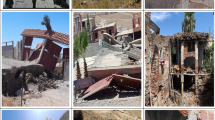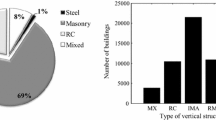Abstract
Soon after the earthquake that damaged L’Aquila municipality and its Province in the Abruzzi Region, Italy, on the 6th of April 2009, a widespread damage and usability assessment of buildings was launched. In 3 months, about 70,000 buildings were inspected, with the AeDES form, by public servants and professionals coordinated by the Italian Civil Protection Department. The paper, after describing the procedures and the form that were used for the assessment, discusses the time evolution of the inspections and analyses the data on building type and seismic damage. The empirical damage distribution conditional upon seismic intensity and building type is provided and the role of several vulnerability factors, such as the quality of masonry, the construction year, the number of stories, and the pre-existing damage, is highlighted. Lastly the damage consequences, such as the immediate occupancy conditional upon building damage and building type, are reported.














Similar content being viewed by others
References
Azzaro R, Barbano MS, D’Amico S, Tuvè T, Scarfì L, Mostaccio A (2011) The L’Aquila 2009 earthquake: an application of the European Macroseismic Scale to the damage survey in the epicentral area. Bollettino di Geofisica Teorica ed Applicata 52(3):561–581. doi:10.4430/bgta0012
Baggio C, Bernardini A, Colozza R, Coppari S, Corazza L, Della Bella M, Di Pasquale G, Dolce M, Goretti A, Martinelli A, Orsini G, Papa F, Zuccaro G (2007) Field manual for post-earthquake damage and safety assessment and short term countermeasures (Pinto A, Taucer F eds), Translation from Italian: Goretti A, Rota M, JRC Scientific and Technical Reports, EUR 22868 EN-2007
Braga F, Dolce M, Liberatore D (1982) A statistical study on damaged buildings and an ensuing review of the M.S.K.-76 scale, VII ECEE, 431–450, Athens, Greece
Coppari S (2001) S.E.T.: Software for the inspection management and data collection in post-earthquake emergency. Release 3.0.1, National Seismic Survey, Rome, Italy (in Italian)
Di Pasquale G, Goretti A (2001) Functional and economic vulnerability of residential buildings affected by recent Italian earthquakes. X National conference of seismic engineering in Italy, Potenza-Matera, 9–13 September (in Italian)
Dolce M, Di Pasquale G, Albanese V, Benetti D, Bramerini F, Coppari S, Corina A, De Rosa G, De Sortis A, Emili P, Ferlito R, Filippi L, Giordano F, Goretti A, Lucantoni A, Mercuri M, Moroni C, Orlandi N, Paoli G, Papa F, Pizza A, Procida F, Rinaldelli M, Sergio S, Severino M, Speranza E, Veschi A, Zambonelli E, Manfredi G, Di Ludovico M, Palermo G, Prota A, Verderame G, Corazza L, Cifani G, Mannella A, Martinelli A (2009) Quick surveys: post-earthquake usability inspections. Progettazione Sismica 3:97–105
Dolce M, Masi A, Marino M, Vona M (2003) Earthquake damage scenarios of the building stock of Potenza (Southern Italy) including site effects. Bull Earthq Eng 1:115–140
Dolce M (2010) Emergency and post-emergency management of the Abruzzi earthquake. In: 14th European conference on earthquake engineering, Ohrid, Macedonia, 3–8 September 2010, published in M Garevski, A Ansal (eds) Earthquake engineering in Europe, Springer. doi:10.1007/978-90-481-9544-2_19
Galli P, Camassi R, Azzaro R, Bernardini F, Castenetto S, Molin D, Peronace E, Rossi A, Vecchi M, Tertulliani A (2009) The 6th of April 2009 L’Aquila earthquake: macroseismic intensities, surface effects and sismotectonics implications. Il Quat Italian J Quat Sci 22(2):235–246
Goretti A, Bramerini F, Di Pasquale G, Dolce M, Lagomarsino S, Parodi S, Iervolino I, Verderame GM, Bernardini A, Penna A, Rota M, Masi A, Vona M (2008) The Italian contribution to the USGS pager project. In: Proceedings of the 14th WCEE, Beijing, China, Paper No 21
Goretti A, De Sortis A (2003) Damage due to the 2002 Etna earthquake. Ing Sismica XX(1):5–20 (In Italian)
Goretti A, Di Pasquale G (2002) An overview of post-earthquake damage assessment in Italy. In: EERI invitational workshop an action plan to develop earthquake damage and loss data protocols, 19–20 September. Pasadena, CA
Goretti A, Di Pasquale G (2004) Building inspection and damage data for the 2002 Molise, Italy, earthquake. Earthq Spectra 20 (special Issue I):167–190
Goretti A, Di Pasquale G (2005) Technical emergency managing. In: Oliveira CS, Roca A, Goula X (eds) Assessing and managing earthquake risk. Kluwer, The Netherlands
Grunthal G (1998) European Macroseismic Scale 1998. Cahiers du Centre Européen de Géodynamique et de Séismologie 15:1–97
Sieberg A (1930) Geologie der Erdbeben. Handbuch der Geophysik 2(4):552–555
Working group for the upgrade of the building inventory and vulnerability (2002) Final report. Department of Civil Protection-National Seismic Survey, December (in Italian)
Author information
Authors and Affiliations
Corresponding author
Rights and permissions
About this article
Cite this article
Dolce, M., Goretti, A. Building damage assessment after the 2009 Abruzzi earthquake. Bull Earthquake Eng 13, 2241–2264 (2015). https://doi.org/10.1007/s10518-015-9723-4
Received:
Accepted:
Published:
Issue Date:
DOI: https://doi.org/10.1007/s10518-015-9723-4




